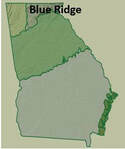The Blue Ridge Ecoregion of Georgia: Overview

The Blue Ridge ecoregion is Georgia's highest, coolest ecoregion, with a rugged topography of metamorphic rock. Here on high ridges many species reach their southernmost range, including a number that are endemic to (found only in) the Southern and Central Appalachians, and some that remain from the last glaciation. Many plant species that were common at lower elevations during the last ice age survive as remnant populations only at high elevations now. Species of salamanders, millipedes, trilliums, and snails also exist in great variety in the southern Appalachians. Fortunately, a large percentage of this ecoregion in Georgia is protected in the Chattahoochee National Forest, as well as in Unicoi, Vogel, Amicalola, and Fort Mountain State parks. Covering less than 5% of the state, the Georgia Blue Ridge makes an out-sized contribution to scenic beauty and biodiversity.
Geology: The Blue Ridge is made of a mosaic of metamorphic rocks. Mafic rocks, like amphibolite and, more rarely, marble, weather to form more alkaline soils. Quartzite weathers to acidic, sandy, sterile soils. The most common rocks, schist and gneiss create fairly acidic soils, but with significantly more nutrients than those from quartzite. The different rock types are described here.
Topography: European settlers advancing west from the populated seaboard of the mid-Atlantic colonies saw the easternmost escarpment of the Appalachians as a hazy blue ridge looming over the more gently rolling Piedmont. This ecoregion has the sharpest relief in Georgia There are 37 peaks above 4,000 feet in elevation; four are over 4,500 feet. Georgia's highest peak, Brasstown Bald, is 4,783 feet high.
The variation in topography and geology leads to a diverse mix of natural communities that are often packed tightly together on the mountain slopes: high rocky summits with views of endless ridges; waterfalls tumbling to rocky pools; lush, fertile coves; and mountain bogs with carpets of sphagnum moss and carnivorous pitcher blogs.
Forest and Woodland Communities
Northern Hardwoods and Boulderfield Forests
Montane Oak Forests
Mesic (Cove) Forests
Low- to Mid-Elevation Oak Forests
Pine-Oak Woodlands
Serpentine (Ultramafic) Barrens and Woodlands
Upland Open Communities: Glades, Barrens and Rock Outcrops
High Elevation Rock Outcrops (Rocky Summits)
Low- to Mid-Elevation Acidic Cliffs and Outcrops
Low to Mid Elevation Mafic Domes, Glades, and Barrens
Wetlands Communities
Mountain Bogs
Seepage Wetlands
Spray Cliffs
Bottomlands and Floodplains
Geology: The Blue Ridge is made of a mosaic of metamorphic rocks. Mafic rocks, like amphibolite and, more rarely, marble, weather to form more alkaline soils. Quartzite weathers to acidic, sandy, sterile soils. The most common rocks, schist and gneiss create fairly acidic soils, but with significantly more nutrients than those from quartzite. The different rock types are described here.
Topography: European settlers advancing west from the populated seaboard of the mid-Atlantic colonies saw the easternmost escarpment of the Appalachians as a hazy blue ridge looming over the more gently rolling Piedmont. This ecoregion has the sharpest relief in Georgia There are 37 peaks above 4,000 feet in elevation; four are over 4,500 feet. Georgia's highest peak, Brasstown Bald, is 4,783 feet high.
The variation in topography and geology leads to a diverse mix of natural communities that are often packed tightly together on the mountain slopes: high rocky summits with views of endless ridges; waterfalls tumbling to rocky pools; lush, fertile coves; and mountain bogs with carpets of sphagnum moss and carnivorous pitcher blogs.
Forest and Woodland Communities
Northern Hardwoods and Boulderfield Forests
Montane Oak Forests
Mesic (Cove) Forests
Low- to Mid-Elevation Oak Forests
Pine-Oak Woodlands
Serpentine (Ultramafic) Barrens and Woodlands
Upland Open Communities: Glades, Barrens and Rock Outcrops
High Elevation Rock Outcrops (Rocky Summits)
Low- to Mid-Elevation Acidic Cliffs and Outcrops
Low to Mid Elevation Mafic Domes, Glades, and Barrens
Wetlands Communities
Mountain Bogs
Seepage Wetlands
Spray Cliffs
Bottomlands and Floodplains

